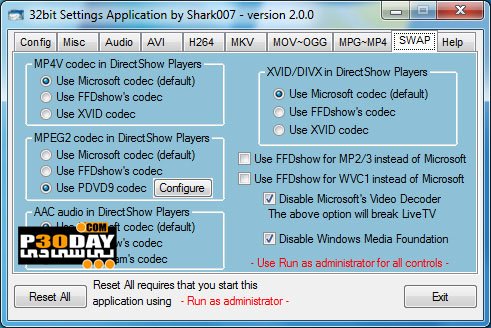

This can be especially useful for video projects in which exact synchronisation is important. “It can be 24-bit, 32-bit, all the way up to 192kHz sample rate and even higher these days.” If you’re collaborating and sending files back and forth, WAV holds its time code. “It’s the highest quality,” Berry agrees. “WAV has greater dynamic range and greater bit depth,” creative producer and sound mixer Lo Boutillette says of her preferred format. WAV (Waveform Audio File) retains all the original data, which makes it the ideal format for sound engineers. These files remain the same size from origin to destination.
#ADVANCE AUDIO CODEC FREE#
Lossless bitrates depend on the volume and density of the music, rather than the quality of the audio.įree Lossless Audio Codec offers lossless compression and it’s free and open-source.Īpple’s Lossless Audio Codec allows for lossless compression, but it works only on Apple devices. These files can be several times larger than MP3s. Audio professionals want all of the original sound waves, so they prefer lossless. These files decompress back to their original size, keeping sound quality intact. Experts consider it a more efficient format than MP3, with better sound at the same bitrate. It’s great for streaming, but the compression results in some data loss. Ogg Vorbis is the free, open-source audio codec that Spotify uses. Requiring less than 1 MB per minute of music and sounding better than MP3 at the same bitrate, the AAC format is used by iTunes/Apple Music, YouTube and Android. “You want to be working in at least 24-bit or higher when recording and mixing.”Īdvanced Audio Coding or AAC files (also known as MPEG-4 AAC), take up very little space and are good for streaming, especially over mobile devices. “MP3 files can only be up to 16-bit, which is not what you want to be working in,” says producer, mixer and engineer Gus Berry. MP3 is fine for the consumer, since most of the sound it drops is inaudible, but that’s not the case when it comes to bit depth. MP3 files work on most devices and the files can be as small as one-tenth the size of lossless files. MP3 (MPEG-1 Audio Layer III) is the most popular of the lossy formats. Artists and engineers who send audio files back and forth prefer not to use lossy formats, because the files degrade every time they’re exported. They don’t decompress back to their original file size, so they end up smaller and some sound waves are lost. All other trademarks are property of their respective owners.Lossy audio formats lose data in the transmission. Qt and respective logos are trademarks of The Qt Company Ltd.
#ADVANCE AUDIO CODEC SOFTWARE#
The documentation provided herein is licensed under the terms of the GNU Free Documentation License version 1.3 as published by the Free Software Foundation. Returns true if other is equal to the current media format, otherwise returns false.ĭocumentation contributions included herein are the copyrights of bool QMediaFormat:: operator=(const QMediaFormat & other) const Moves other into this QMediaFormat objects. QMediaFormat &QMediaFormat:: operator=( QMediaFormat & other) QMediaFormat &QMediaFormat:: operator=(const QMediaFormat & other)Ĭopies other into this QMediaFormat object. Returns true if other is not equal to the current media format, otherwise returns false. bool QMediaFormat:: operator!=(const QMediaFormat & other) const Note: This function can be invoked via the meta-object system and from QML. Operator=(const QMediaFormat & other) const Operator!=(const QMediaFormat & other) const

SupportedVideoCodecs(QMediaFormat::ConversionMode m) SupportedFileFormats(QMediaFormat::ConversionMode m) SupportedAudioCodecs(QMediaFormat::ConversionMode m) SetVideoCodec(QMediaFormat::VideoCodec codec) SetFileFormat(QMediaFormat::FileFormat f) SetAudioCodec(QMediaFormat::AudioCodec codec) ResolveForEncoding(QMediaFormat::ResolveFlags flags) IsSupported(QMediaFormat::ConversionMode mode) const QMediaFormat(QMediaFormat::FileFormat format = UnspecifiedFormat)


 0 kommentar(er)
0 kommentar(er)
